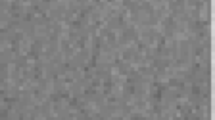Abstract
Grain-size distribution or aggregate gradation is one of the key factors affecting the various branches of civil engineering such as geotechnical engineering, river hydraulics and mechanics of sediment transport, material engineering and concrete technology. Sieve analysis (mechanical gradation) of aggregates that is performed using standard sieves needs a lot of cost and time. Therefore, the use of novel methods such as image processing is important and undeniable in the development of industries that deal with aggregate gradation. In this paper, an efficient procedure is suggested to determine the particle size distribution based on a new parameter called self-adaptive size parameter. This parameter is minimum dimension of the equivalent shape of a particle that is calculated by the proposed algorithm. In present research, two aggregate samples with different gradations were employed to demonstrate the efficiency and accuracy of the proposed procedure. For this purpose, the images of the aggregate samples obtained from Aji Chay River, located in the northwest of Iran, were taken using an 8MP camera. The resulting images were then processed using Geological Image Analysis Software and the proposed algorithm as a MATLAB-based program. The study of the output graphs indicates that a good agreement exists between the results from sieve analysis and those from the theoretical gradation based on the proposed procedure.





















Similar content being viewed by others
References
Al-Rawas AA, Goosen MF (eds) (2006) Expansive soils: recent advances in characterization and treatment. Taylor & Francis, New York
Aydemir S, Keskin S, Drees LR (2004) Quantification of soil features using digital image processing (DIP) techniques. Geoderma 119(1):1–8
Baptista P, Cunha TR, Gama C, Bernardes C (2012) A new and practical method to obtain grain size measurements in sandy shores based on digital image acquisition and processing. Sed Geol 282:294–306
Barbosa FS, Farage MCR, Beaucour AL, Ortola S (2012) Evaluation of aggregate gradation in lightweight concrete via image processing. Constr Build Mater 29:7–11
Beggan C, Hamilton CW (2010) New image processing software for analyzing object size-frequency distributions, geometry, orientation, and spatial distribution. Comput Geosci 36(4):539–549
Chang FJ, Chung CH (2012) Estimation of riverbed grain-size distribution using image-processing techniques. J Hydrol 440:102–112
Fabbri AG (1984) Image processing of geological data. Van Nostrand Reinhold, New York
Guerrieri M (2014) Railway ballast scanning by means of DIP system. ARPN J Eng Appl Sci 9(12):2618–2624
Guerrieri M, Parla G (2013) A new high-efficiency procedure for aggregate gradation determination of the railway ballast by means image recognition method. Arch Civil Eng 59(4):469–482
Guerrieri M, Parla G, Ticali D, Corriere F (2012a) Tramway track: a new approach for measuring the transverse profile of worn-out rails. AASRI Procedia 3:451–456
Guerrieri M, Parla G, Ticali D (2012b) A theoretical and experimental approach to reconstructing the transverse profile of worn-out rails. Ing Ferrov 67(1):23–37
Hoey TB, Ferguson R (1994) Numerical simulation of downstream fining by selective transport in gravel bed rivers: model development and illustration. Water Resour Res 30(7):2251–2260
Hryciw R, Raschke S (1996) Development of computer vision technique for in situ soil characterization. Transp Res Rec J Transp Res Board 1526:86–97
Hryciw RD, Ghalib AM, Raschke SA (1998) Methods for soil characterization from images of grain assemblies. In: Second international conference on imaging technologies: techniques and applications in civil engineering
Hudson B (1999) Modification to the fine aggregate angularity test. In: Proceedings, seventh annual international center for aggregates research symposium, Austin, TX
Lange J, Benning W, Siering K (2006) Crack detection at concrete construction units from photogrammetric data using image processing procedures. In: ISPRS commission VII mid-term symposium remote sensing: from pixels to processes, Enschede, Netherlands, pp 493–496
Mao L, Surian N (2010) Observations on sediment mobility in a large gravel-bed river. Geomorphology 114(3):326–337
Mitchell JK (1993) Fundamentals of soil behavior. Wiley, New York
Młynarczuk M (2013) Determining rock pore space using image processing methods. Geol Geophys Environ 39(1):45–54
Moaveni M, Wang S, Hart J, Tutumluer E, Ahuja N (2013) Evaluation of aggregate size and shape by means of segmentation techniques and aggregate image processing algorithms. Transp Res Rec J Transp Res Board 2335:50–59
Molder C, Serban F, Vizitiu IC, Stanciu MI (2008) Image processing for sediment classification. In: Proceedings of the 7th WSEAS international conference on computational intelligence, man-machine systems and cybernetics. World Scientific and Engineering Academy and Society (WSEAS), pp 113–118
Ozen M (2007) Investigation of relationship between aggregate shape parameters and concrete strength using imaging techniques. Doctoral dissertation, Middle East Technical University
Ozen M, Guler M (2014) Assessment of optimum threshold and particle shape parameter for the image analysis of aggregate size distribution of concrete sections. Opt Lasers Eng 53:122–132
Peng X, Horn R, Peth S, Smucker A (2006) Quantification of soil shrinkage in 2D by digital image processing of soil surface. Soil Tillage Res 91(1):173–180
Rice S (1999) The nature and controls on downstream fining within sedimentary links. J Sediment Res 69(1):32–39
Romero-Ramirez A, Gremare A, Desmalades M, Duchêne JC (2013) Semi-automatic analysis and interpretation of sediment profile images. Environ Model Softw 47:42–54
Stock AF, Hannantt DJ, Williams RIT (1979) The effect of aggregate concentration upon the strength and modulus of elasticity of concrete. Mag Concr Res 31(109):225–234
Xu WX, Lv Z, Chen HS (2013) Effects of particle size distribution, shape and volume fraction of aggregates on the wall effect of concrete via random sequential packing of polydispersed ellipsoidal particles. Phys A 392(3):416–426
Yamaguchi T, Nakamura S, Saegusa R, Hashimoto S (2008) Image-based crack detection for real concrete surfaces. IEEJ Trans Electr Electron Eng 3(1):128–135
Author information
Authors and Affiliations
Corresponding author
Rights and permissions
About this article
Cite this article
Damadipour, M., Nazarpour, M. & Alami, M.T. Evaluation of Particle Size Distribution Using an Efficient Approach Based on Image Processing Techniques. Iran J Sci Technol Trans Civ Eng 43 (Suppl 1), 429–441 (2019). https://doi.org/10.1007/s40996-018-0175-3
Received:
Accepted:
Published:
Issue Date:
DOI: https://doi.org/10.1007/s40996-018-0175-3




